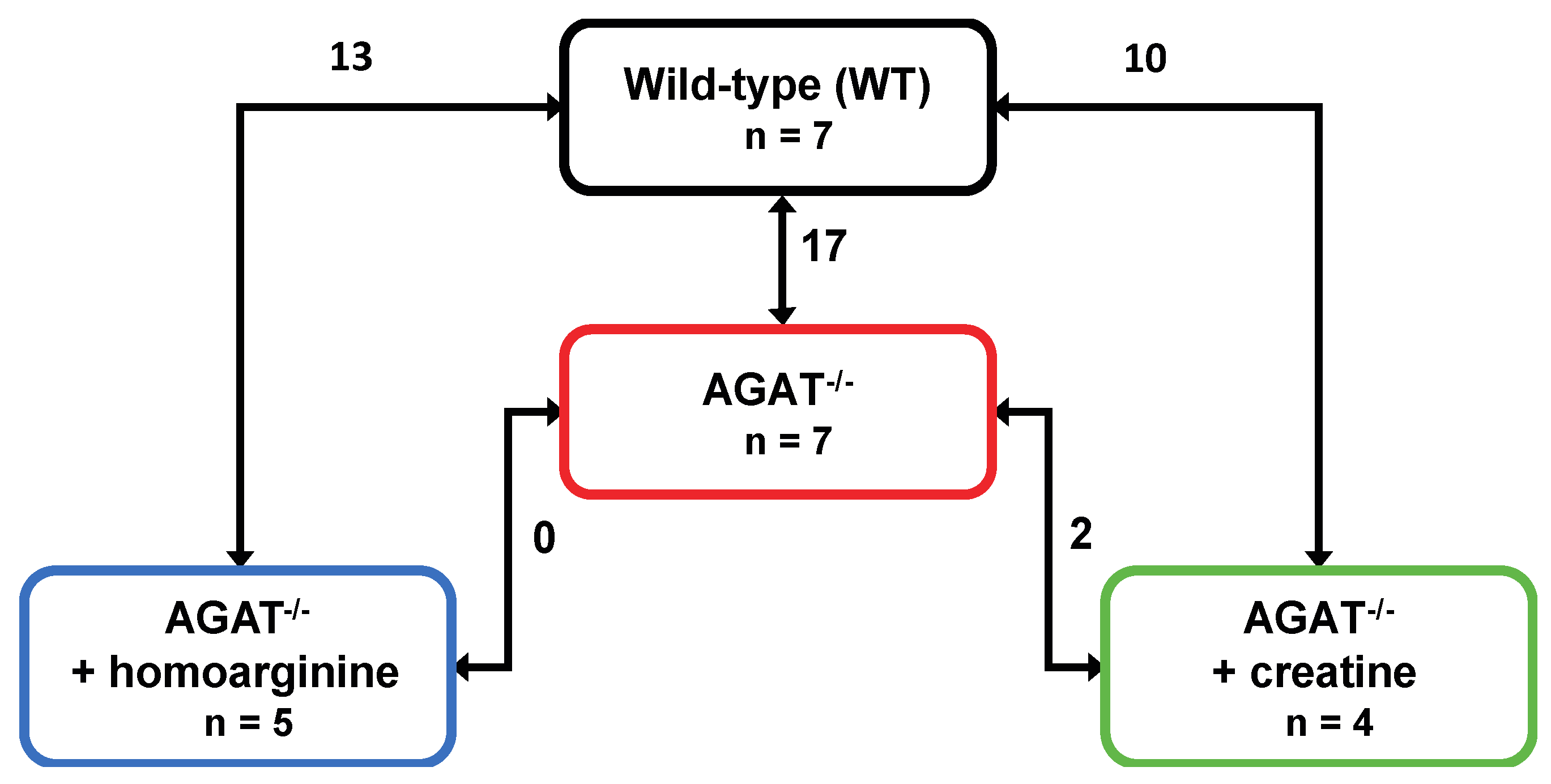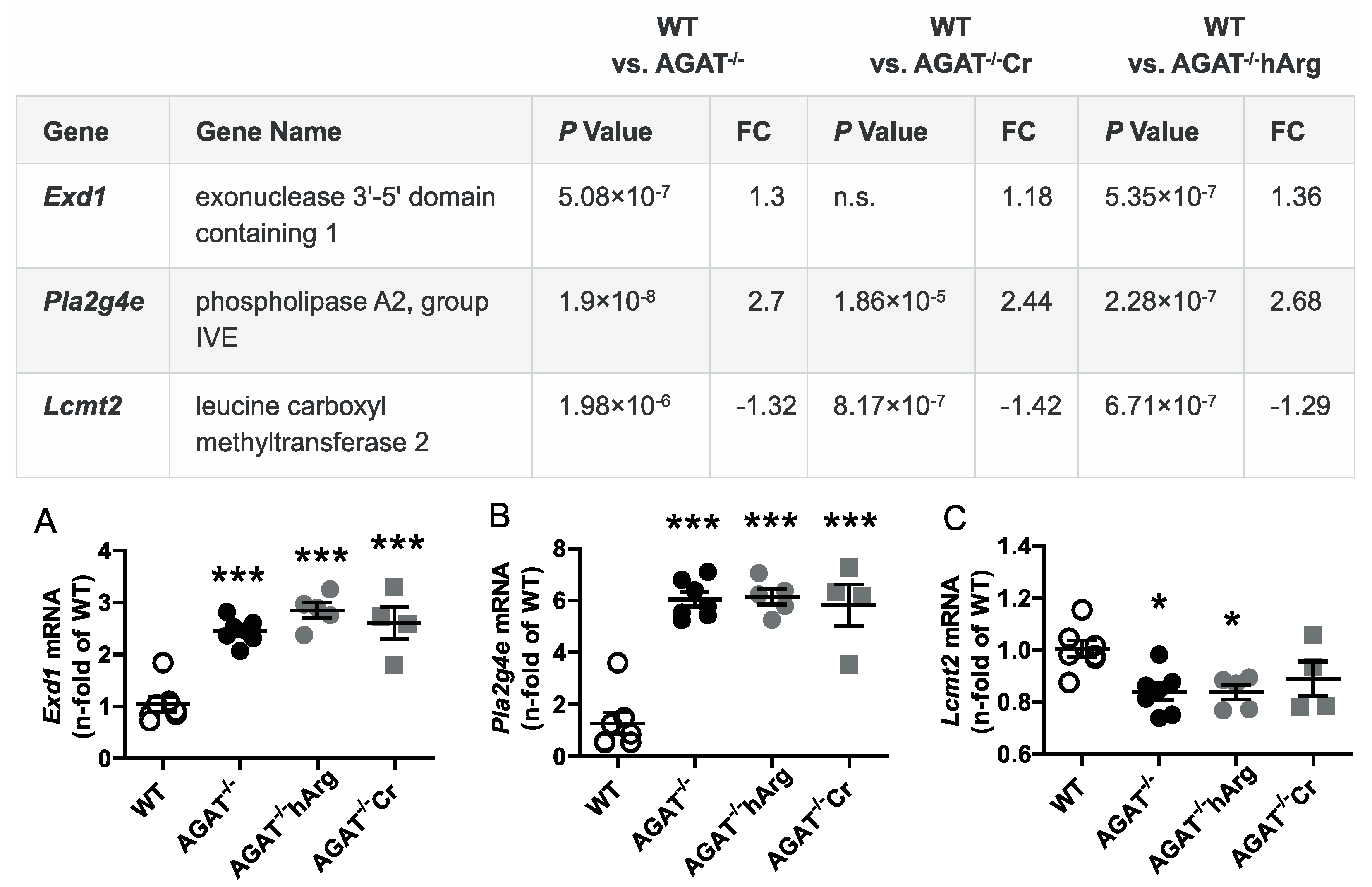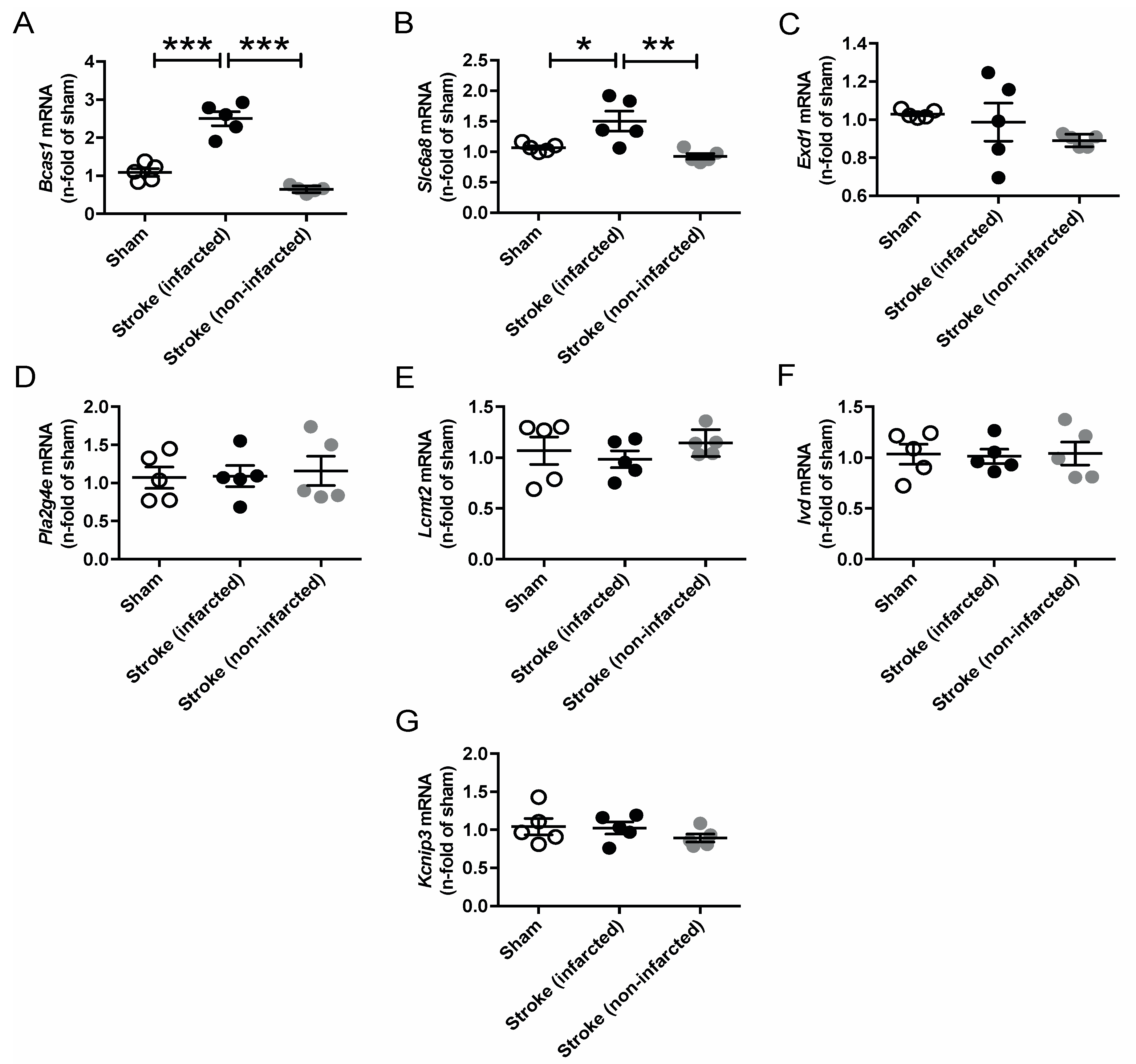Homoarginine- and Creatine-Dependent Gene Regulation in Murine Brains with l-Arginine:Glycine Amidinotransferase Deficiency
Abstract
1. Introduction
2. Results
2.1. Gene Expression Differences between WT and AGAT−/− Mice in Brain Samples
2.2. Creatine- and hArg-Dependent Gene Regulation in the brain
2.3. Selection and Validation of Cerebrovascular Candidate Genes
2.4. Confirmation of Candidate Gene Expression in a Mouse Model of Ischemic Stroke
2.5. Amino acid Analysis in Brain Tissue of AGAT−/− Mice
3. Discussion
4. Materials and Methods
4.1. Care and Trearment of Mice
4.2. Tissue Collection and Preparation
4.3. RNA Isolation from Murine Tissue
4.4. In vivo Model of Ischemic Stroke in Mice
4.5. Gene Expression Analysis by Microarray
4.6. Reverse Transcription and Quantitative Polymerase Chain Reaction (qPCR)
4.7. Amino acid Analysis
4.8. Bioinformatics Analysis
4.9. Metabolome Analysis
4.10. Statistical Analysis
Author Contributions
Funding
Conflicts of Interest
References
- Nouioua, S.; Cheillan, D.; Zaouidi, S.; Salomons, G.S.; Amedjout, N.; Kessaci, F.; Boulahdour, N.; Hamadouche, T.; Tazir, M. Creatine deficiency syndrome. A treatable myopathy due to arginine-glycine amidinotransferase (AGAT) deficiency. Neuromuscul. Disord. 2013, 23, 670–674. [Google Scholar] [CrossRef] [PubMed]
- Stockler-Ipsiroglu, S.; Apatean, D.; Battini, R.; DeBrosse, S.; Dessoffy, K.; Edvardson, S.; Eichler, F.; Johnston, K.; Koeller, D.M.; Nouioua, S.; et al. Arginine:glycine amidinotransferase (AGAT) deficiency: Clinical features and long term outcomes in 16 patients diagnosed worldwide. Mol. Genet. Metab. 2015, 116, 252–259. [Google Scholar] [CrossRef] [PubMed]
- Braissant, O.; Henry, H.; Beard, E.; Uldry, J. Creatine deficiency syndromes and the importance of creatine synthesis in the brain. Amino Acids 2011, 40, 1315–1324. [Google Scholar] [CrossRef] [PubMed]
- Joncquel-Chevalier Curt, M.; Voicu, P.M.; Fontaine, M.; Dessein, A.F.; Porchet, N.; Mention-Mulliez, K.; Dobbelaere, D.; Soto-Ares, G.; Cheillan, D.; Vamecq, J. Creatine biosynthesis and transport in health and disease. Biochimie 2015, 119, 146–165. [Google Scholar] [CrossRef] [PubMed]
- Zhu, S.; Li, M.; Figueroa, B.E.; Liu, A.; Stavrovskaya, I.G.; Pasinelli, P.; Beal, M.F.; Brown, R.H., Jr.; Kristal, B.S.; Ferrante, R.J.; et al. Prophylactic creatine administration mediates neuroprotection in cerebral ischemia in mice. J. Neurosci. 2004, 24, 5909–5912. [Google Scholar] [CrossRef]
- Prass, K.; Royl, G.; Lindauer, U.; Freyer, D.; Megow, D.; Dirnagl, U.; Stockler-Ipsiroglu, G.; Wallimann, T.; Priller, J. Improved reperfusion and neuroprotection by creatine in a mouse model of stroke. J. Cereb. Blood Flow Metab. 2007, 27, 452–459. [Google Scholar] [CrossRef]
- Turner, C.E.; Byblow, W.D.; Gant, N. Creatine supplementation enhances corticomotor excitability and cognitive performance during oxygen deprivation. J. Neurosci. 2015, 35, 1773–1780. [Google Scholar] [CrossRef]
- Pilz, S.; Tomaschitz, A.; Meinitzer, A.; Drechsler, C.; Ritz, E.; Krane, V.; Wanner, C.; Bohm, B.O.; Marz, W. Low serum homoarginine is a novel risk factor for fatal strokes in patients undergoing coronary angiography. Stroke 2011, 42, 1132–1134. [Google Scholar] [CrossRef]
- Choe, C.U.; Atzler, D.; Wild, P.S.; Carter, A.M.; Boger, R.H.; Ojeda, F.; Simova, O.; Stockebrand, M.; Lackner, K.; Nabuurs, C.; et al. Homoarginine levels are regulated by L-arginine:glycine amidinotransferase and affect stroke outcome: Results from human and murine studies. Circulation 2013, 128, 1451–1461. [Google Scholar] [CrossRef]
- Hrabak, A.; Bajor, T.; Temesi, A. Comparison of substrate and inhibitor specificity of arginase and nitric oxide (NO) synthase for arginine analogues and related compounds in murine and rat macrophages. Biochem. Biophys. Res. Commun. 1994, 198, 206–212. [Google Scholar] [CrossRef]
- Atzler, D.; Gore, M.O.; Ayers, C.R.; Choe, C.U.; Boger, R.H.; de Lemos, J.A.; McGuire, D.K.; Schwedhelm, E. Homoarginine and cardiovascular outcome in the population-based Dallas Heart Study. Arterioscler. Thromb. Vasc. Biol. 2014, 34, 2501–2507. [Google Scholar] [CrossRef] [PubMed]
- Haghikia, A.; Yanchev, G.R.; Kayacelebi, A.A.; Hanff, E.; Bledau, N.; Widera, C.; Sonnenschein, K.; Haghikia, A.; Weissenborn, K.; Bauersachs, J.; et al. The role of L-arginine/L-homoarginine/nitric oxide pathway for aortic distensibility and intima-media thickness in stroke patients. Amino Acids 2017, 49, 1111–1121. [Google Scholar] [CrossRef] [PubMed]
- Cordts, K.; Grzybowski, R.; Lezius, S.; Luneburg, N.; Atzler, D.; Neu, A.; Hornig, S.; Boger, R.H.; Gerloff, C.; Magnus, T.; et al. Guanidino compound ratios are associated with stroke etiology, internal carotid artery stenosis and CHA2DS2-VASc score in three cross-sectional studies. J. Neurol. Sci. 2019, 397, 156–161. [Google Scholar] [CrossRef] [PubMed]
- Kleber, M.E.; Seppala, I.; Pilz, S.; Hoffmann, M.M.; Tomaschitz, A.; Oksala, N.; Raitoharju, E.; Lyytikainen, L.P.; Makela, K.M.; Laaksonen, R.; et al. Genome-wide association study identifies 3 genomic loci significantly associated with serum levels of homoarginine: The AtheroRemo Consortium. Circ. Cardiovasc. Genet. 2013, 6, 505–513. [Google Scholar] [CrossRef]
- Atzler, D.; McAndrew, D.J.; Cordts, K.; Schneider, J.E.; Zervou, S.; Schwedhelm, E.; Neubauer, S.; Lygate, C.A. Dietary Supplementation with Homoarginine Preserves Cardiac Function in a Murine Model of Post-Myocardial Infarction Heart Failure. Circulation 2017, 135, 400–402. [Google Scholar] [CrossRef]
- Wetzel, M.D.; Gao, T.; Venkatachalam, M.; Morris, S.M., Jr.; Awad, A.S. l-Homoarginine supplementation prevents diabetic kidney damage. Physiol. Rep. 2019, 7, e14235. [Google Scholar] [CrossRef]
- Rodionov, R.N.; Begmatov, H.; Jarzebska, N.; Patel, K.; Mills, M.T.; Ghani, Z.; Khakshour, D.; Tamboli, P.; Patel, M.N.; Abdalla, M.; et al. Homoarginine Supplementation Prevents Left Ventricular Dilatation and Preserves Systolic Function in a Model of Coronary Artery Disease. J. Am. Heart Assoc. 2019, 8, e012486. [Google Scholar] [CrossRef]
- Dellera, F.; Ganzetti, G.S.; Froio, A.; Manzini, S.; Busnelli, M.; Meinitzer, A.; Sirtori, C.R.; Chiesa, G.; Parolini, C. L-homoarginine administration reduces neointimal hyperplasia in balloon-injured rat carotids. Thromb. Haemost. 2016, 116, 400–402. [Google Scholar] [CrossRef]
- Iqbal, F.; Hoeger, H.; Lubec, G.; Bodamer, O. Biochemical and behavioral phenotype of AGAT and GAMT deficient mice following long-term Creatine monohydrate supplementation. Metab. Brain Dis. 2017, 32, 1951–1961. [Google Scholar] [CrossRef]
- Ishimoto, T.; Ninomiya, K.; Inoue, R.; Koike, M.; Uchiyama, Y.; Mori, H. Mice lacking BCAS1, a novel myelin-associated protein, display hypomyelination, schizophrenia-like abnormal behaviors, and upregulation of inflammatory genes in the brain. Glia 2017, 65, 727–739. [Google Scholar] [CrossRef]
- Jin, J.K.; Choi, J.K.; Wasco, W.; Buxbaum, J.D.; Kozlowski, P.B.; Carp, R.I.; Kim, Y.S.; Choi, E.K. Expression of calsenilin in neurons and astrocytes in the Alzheimer’s disease brain. Neuroreport 2005, 16, 451–455. [Google Scholar] [CrossRef] [PubMed]
- Baroncelli, L.; Molinaro, A.; Cacciante, F.; Alessandri, M.G.; Napoli, D.; Putignano, E.; Tola, J.; Leuzzi, V.; Cioni, G.; Pizzorusso, T. A mouse model for creatine transporter deficiency reveals early onset cognitive impairment and neuropathology associated with brain aging. Hum. Mol. Genet. 2016, 25, 4186–4200. [Google Scholar] [CrossRef] [PubMed]
- Stockebrand, M.; Sasani, A.; Das, D.; Hornig, S.; Hermans-Borgmeyer, I.; Lake, H.A.; Isbrandt, D.; Lygate, C.A.; Heerschap, A.; Neu, A.; et al. A Mouse Model of Creatine Transporter Deficiency Reveals Impaired Motor Function and Muscle Energy Metabolism. Front. Physiol. 2018, 9, 773. [Google Scholar] [CrossRef] [PubMed]
- Grillo, M.A.; Grillo, S.L.; Gerdes, B.C.; Kraus, J.G.; Koulen, P. Control of Neuronal Ryanodine Receptor-Mediated Calcium Signaling by Calsenilin. Mol. Neurobiol. 2019, 56, 525–534. [Google Scholar] [CrossRef] [PubMed]
- Buxbaum, J.D. A role for calsenilin and related proteins in multiple aspects of neuronal function. Biochem Biophys. Res. Commun. 2004, 322, 1140–1144. [Google Scholar] [CrossRef] [PubMed]
- Yudkoff, M.; Daikhin, Y.; Nissim, I.; Horyn, O.; Luhovyy, B.; Luhovyy, B.; Lazarow, A.; Nissim, I. Brain amino acid requirements and toxicity: The example of leucine. J. Nutr. 2005, 135, 1531S–1538S. [Google Scholar] [CrossRef]
- Dingman, A.L.; Rodgers, K.M.; Dietz, R.M.; Hickey, S.P.; Frazier, A.P.; Clevenger, A.C.; Yonchek, J.C.; Traystman, R.J.; Macklin, W.B.; Herson, P.S. Oligodendrocyte Progenitor Cell Proliferation and Fate after White Matter Stroke in Juvenile and Adult Mice. Dev. Neurosci. 2019, 1–16. [Google Scholar] [CrossRef]
- Stockebrand, M.; Nejad, A.S.; Neu, A.; Kharbanda, K.K.; Sauter, K.; Schillemeit, S.; Isbrandt, D.; Choe, C.U. Transcriptomic and metabolic analyses reveal salvage pathways in creatine-deficient AGAT(-/-) mice. Amino Acids 2016, 48, 2025–2039. [Google Scholar] [CrossRef]
- Choe, C.U.; Nabuurs, C.; Stockebrand, M.C.; Neu, A.; Nunes, P.; Morellini, F.; Sauter, K.; Schillemeit, S.; Hermans-Borgmeyer, I.; Marescau, B.; et al. L-arginine:glycine amidinotransferase deficiency protects from metabolic syndrome. Hum. Mol. Genet. 2013, 22, 110–123. [Google Scholar] [CrossRef]
- Stockebrand, M.; Sauter, K.; Neu, A.; Isbrandt, D.; Choe, C.U. Differential regulation of AMPK activation in leptin- and creatine-deficient mice. FASEB J. 2013, 27, 4147–4156. [Google Scholar] [CrossRef]
- Faller, K.M.E.; Atzler, D.; McAndrew, D.J.; Zervou, S.; Whittington, H.J.; Simon, J.N.; Aksentijevic, D.; Ten Hove, M.; Choe, C.U.; Isbrandt, D.; et al. Impaired cardiac contractile function in arginine:glycine amidinotransferase knockout mice devoid of creatine is rescued by homoarginine but not creatine. Cardiovasc. Res. 2018, 114, 417–430. [Google Scholar] [CrossRef] [PubMed]
- Gelderblom, M.; Weymar, A.; Bernreuther, C.; Velden, J.; Arunachalam, P.; Steinbach, K.; Orthey, E.; Arumugam, T.V.; Leypoldt, F.; Simova, O.; et al. Neutralization of the IL-17 axis diminishes neutrophil invasion and protects from ischemic stroke. Blood 2012, 120, 3793–3802. [Google Scholar] [CrossRef] [PubMed]
- Lindner, D.; Li, J.; Savvatis, K.; Klingel, K.; Blankenberg, S.; Tschope, C.; Westermann, D. Cardiac fibroblasts aggravate viral myocarditis: Cell specific coxsackievirus B3 replication. Mediat. Inflamm. 2014, 2014, 519528. [Google Scholar] [CrossRef] [PubMed]
- Livak, K.J.; Schmittgen, T.D. Analysis of relative gene expression data using real-time quantitative PCR and the 2(-Delta Delta C(T)) Method. Methods 2001, 25, 402–408. [Google Scholar] [CrossRef] [PubMed]







| Gene | Gene Name | Discovery Cohort | Validation Cohort | ||
|---|---|---|---|---|---|
| p Value | FC | p Value | FC | ||
| Agat | L-arginine:glycine amidinotransferase | 4.32 × 10−16 | −2.91 | 6.95 × 10−18 | −3.31 |
| Bcas1 | breast carcinoma amplified sequence 1 | 9.07 × 10−11 | 1.6 | 2.68 × 10−8 | 1.45 |
| Slc6a8 | solute carrier family 6 (neurotransmitter transporter, creatine), member 8 | 1.46 × 10−9 | 1.35 | 3.41 × 10−9 | 1.31 |
| Pla2g4e | phospholipase A2, group IVE | 1.9 × 10−8 | 2.7 | 2.85 × 10−16 | 4.33 |
| Tmem87a | transmembrane protein 87A | 1.7 × 10−7 | −1.3 | 1.81 × 10−1 | 1.04 |
| Exd1 | exonuclease 3’−5’ domain containing 1 | 5.08 × 10−7 | 1.3 | 4 × 10−8 | 1.41 |
| Ivd | isovaleryl coenzyme A dehydrogenase | 1.45 × 10−6 | −1.38 | 1.18 × 10−10 | −1.39 |
| Lcmt2 | leucine carboxyl methyltransferase 2 | 1.98 × 10−6 | −1.32 | 3.5 × 10−6 | −1.23 |
| Bloc1s6 | biogenesis of organelles complex-1, subunit 6, pallidin | 2.61 × 10−6 | 1.37 | b.d.l. | - |
| Rmdn3 | regulator of microtubule dynamics 3 | 3.02 × 10−6 | 1.27 | b.d.l. | - |
| Mkks | McKusick–Kaufman syndrome | 3.8 × 10−6 | 1.42 | 3.3 × 10−1 | 1.04 |
| Atp8b1 | ATPase, class I, type 8B, member 1 | 1.02 × 10−5 | −1.27 | 4.84 × 10−3 | −1.14 |
| Myh9 | myosin, heavy polypeptide 9, nonmuscle | 1.19 × 10−5 | −1.21 | 1.84 × 10−2 | −1.07 |
| Kcnip3 | Kv channel interacting protein 3, calsenilin | 1.48 × 10−5 | −1.27 | 4.05 × 10−6 | −1.17 |
| Cdr2 | cerebellar degeneration-related 2 | 2 × 10−5 | 1.2 | 1.32 × 10−2 | 1.1 |
| Plekhb1 | pleckstrin homology domain containing, family B (evectins) member 1 | 2.7 × 10−5 | 1.19 | 2.05 × 10−3 | 1.1 |
| Dmp1 | dentin matrix protein 1 | 3.59 × 10−5 | 1.23 | 8.41 × 10−2 | −1.05 |
| Gene | Gene Name | p Value | FC |
|---|---|---|---|
| Agat | l-arginine:glycine amidinotransferase | 6.64 × 10−13 | −2.85 |
| Lcmt2 | leucine carboxyl methyltransferase 2 | 8.17 × 10−7 | −1.42 |
| Rassf2 | Ras association (RalGDS/AF-6) domain family member 2 | 8.22 × 10−7 | −1.38 |
| Mkks | McKusick–Kaufman syndrome | 1.1 × 10−6 | 1.54 |
| Ivd | isovaleryl coenzyme A dehydrogenase | 6.97 × 10−6 | −1.42 |
| Reps2 | RALBP1 associated Eps domain containing protein 2 | 8.94 × 10−6 | −1.3 |
| Magee2 | melanoma antigen, family E, 2 | 1.03 × 10−5 | −1.37 |
| Prokr2 | prokineticin receptor 2 | 1.04 × 10−5 | −1.31 |
| Tmem47 | transmembrane protein 47 | 1.57 × 10−5 | −1.31 |
| Pla2g4e | phospholipase A2, group IVE | 1.86 × 10−5 | 2.44 |
| Gene | Gene Name | p Value | FC |
|---|---|---|---|
| Agat | l-arginine:glycine amidinotransferase | 2.05 × 10−14 | −2.91 |
| Bcas1 | breast carcinoma amplified sequence 1 | 1.02 × 10−8 | 1.55 |
| Slc6a8 | solute carrier family 6 (neurotransmitter transporter, creatine), member 8 | 6.67 × 10−8 | 1.38 |
| Pla2g4e | phospholipase A2, group IVE | 2.28 × 10−7 | 2.68 |
| Tmem87a | transmembrane protein 87A | 2.52 × 10−7 | −1.35 |
| Exd1 | exonuclease 3’−5’ domain containing 1 | 5.35 × 10−7 | 1.36 |
| Lcmt2 | leucine carboxyl methyltransferase 2 | 6.71 × 10−7 | −1.29 |
| Ivd | isovaleryl coenzyme A dehydrogenase | 1.18 × 10−6 | −1.46 |
| Mkks | McKusick–Kaufman syndrome | 7.82 × 10−6 | 1.36 |
| Cd59a | CD59a antigen | 1.09 × 10−5 | 1.35 |
| B2m | beta-2 microglobulin | 1.52 × 10−5 | −1.35 |
| Prokr2 | prokineticin receptor 2 | 1.59 × 10−5 | −1.31 |
| Nfkbia | nuclear factor of kappa light polypeptide gene enhancer in B cells inhibitor, alpha | 2.2 × 10−5 | 1.37 |
| Gene | Assay ID |
|---|---|
| Bcas1 | Mm00659626_m1 |
| Slc6a8 | Mm00506023_m1 |
| Ivd | Mm00498171_m1 |
| Lcmt2 | Mm03647220_s1 |
| Kcnip3 | Mm01339777_m1 |
| Pla2g4e | Mm00625711_m1 |
| Exd1 | Mm00556180_m1 |
© 2020 by the authors. Licensee MDPI, Basel, Switzerland. This article is an open access article distributed under the terms and conditions of the Creative Commons Attribution (CC BY) license (http://creativecommons.org/licenses/by/4.0/).
Share and Cite
Jensen, M.; Müller, C.; Schwedhelm, E.; Arunachalam, P.; Gelderblom, M.; Magnus, T.; Gerloff, C.; Zeller, T.; Choe, C.-u. Homoarginine- and Creatine-Dependent Gene Regulation in Murine Brains with l-Arginine:Glycine Amidinotransferase Deficiency. Int. J. Mol. Sci. 2020, 21, 1865. https://doi.org/10.3390/ijms21051865
Jensen M, Müller C, Schwedhelm E, Arunachalam P, Gelderblom M, Magnus T, Gerloff C, Zeller T, Choe C-u. Homoarginine- and Creatine-Dependent Gene Regulation in Murine Brains with l-Arginine:Glycine Amidinotransferase Deficiency. International Journal of Molecular Sciences. 2020; 21(5):1865. https://doi.org/10.3390/ijms21051865
Chicago/Turabian StyleJensen, Märit, Christian Müller, Edzard Schwedhelm, Priyadharshini Arunachalam, Mathias Gelderblom, Tim Magnus, Christian Gerloff, Tanja Zeller, and Chi-un Choe. 2020. "Homoarginine- and Creatine-Dependent Gene Regulation in Murine Brains with l-Arginine:Glycine Amidinotransferase Deficiency" International Journal of Molecular Sciences 21, no. 5: 1865. https://doi.org/10.3390/ijms21051865
APA StyleJensen, M., Müller, C., Schwedhelm, E., Arunachalam, P., Gelderblom, M., Magnus, T., Gerloff, C., Zeller, T., & Choe, C.-u. (2020). Homoarginine- and Creatine-Dependent Gene Regulation in Murine Brains with l-Arginine:Glycine Amidinotransferase Deficiency. International Journal of Molecular Sciences, 21(5), 1865. https://doi.org/10.3390/ijms21051865







